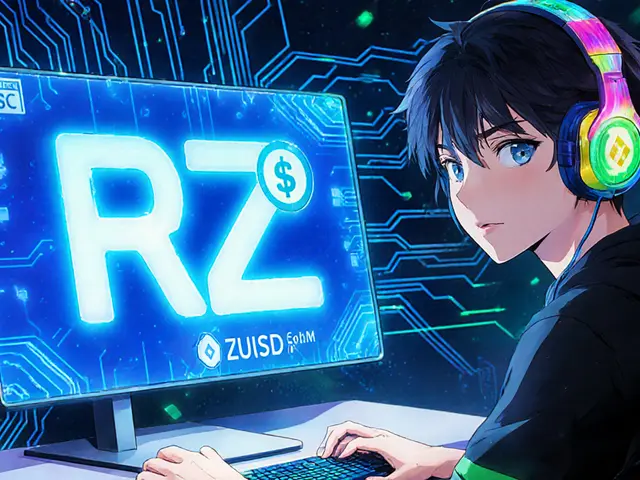Want to move your crypto from Binance Smart Chain to Polygon without paying $50 in gas fees and waiting 10 minutes? Most exchanges make this a nightmare. Elk Finance says it fixes that - and it’s built specifically for users tired of juggling multiple wallets and paying insane fees just to swap tokens across chains.
What Is Elk Finance (BSC)?
Elk Finance isn’t another centralized exchange like Binance or Coinbase. It’s a decentralized exchange (DEX) built on a cross-chain liquidity protocol that lets you swap tokens between 14 different blockchains without leaving your wallet. Think of it like a universal adapter for crypto - you plug in your ETH on Ethereum, and out comes MATIC on Polygon, with no middleman holding your coins.
It launched with support for major chains like Binance Smart Chain (BSC), Ethereum, Arbitrum, Polygon, and Avalanche. The platform’s whole design revolves around one idea: make cross-chain swaps as easy as 1, 2, 3. No complex bridging. No waiting for confirmations across networks. Just pick your tokens, pick your destination chain, and hit swap.
Unlike platforms like Uniswap that focus on trading within one chain, Elk Finance is built for the multi-chain world we live in now. If you’re holding tokens on different networks - and most serious crypto users are - Elk Finance removes the friction.
How Elk Finance Works on BSC
Using Elk Finance on BSC is straightforward. You connect your wallet - MetaMask, Trust Wallet, or any Web3 wallet that supports BSC - and you’re instantly connected to Elk’s liquidity pools. The interface shows you what tokens you can swap and what chains they’re available on.
For example: you’ve got $100 worth of BNB on BSC and want to move it to Polygon to stake in a yield farm. Instead of sending BNB to a bridge, waiting 5-15 minutes, paying gas on both ends, and then swapping again on a DEX like QuickSwap - you do it all in one click on Elk Finance.
The platform uses automated market maker (AMM) pools, similar to Uniswap, but instead of pools locked to one chain, Elk’s pools are interconnected across chains. When you swap, the protocol finds the most efficient route - sometimes routing through intermediate tokens - to get you the best rate and lowest cost.
Transaction fees on BSC are low to begin with, and Elk Finance keeps them even lower by optimizing paths and minimizing hops. Most swaps cost under $0.50 in gas, even when crossing chains.
ELK Token: More Than Just a Utility Coin
The native token, ELK is used for governance, fee discounts, and liquidity mining rewards. You can’t swap tokens on Elk Finance without paying a small fee in ELK, but holding it gives you a 30% discount on those fees.
What makes ELK stand out is its liquidity provider (LP) protection feature. Most DeFi platforms promise high yields, but if the price of your deposited tokens drops, you lose money - that’s called impermanent loss. Elk Finance guarantees that if you provide liquidity, you’ll never walk away with less than your original deposit value. That’s rare. In fact, it’s almost unheard of in DeFi.
How? The protocol uses a reserve fund to cover losses. If the value of your LP position falls below your initial stake, Elk Finance tops it up from its treasury. This isn’t insurance - it’s baked into the code. It’s designed to attract long-term liquidity providers who don’t want to gamble on token prices.
As of November 2025, ELK is trading around $0.024, down 7.3% over the past week. That sounds bad - until you compare it to the broader crypto market, which dropped 9.4% in the same period. Elk Finance’s token is holding up better than most.
Still, WalletInvestor predicts ELK will fall to $0.01962 by year-end, calling it a “poor investment.” That’s based purely on algorithmic price modeling - not real-world usage. The token’s value isn’t just about speculation. It’s tied to how much volume flows through the platform. More swaps = more ELK fees collected = more value for holders.

How Elk Finance Compares to Other Platforms
Let’s cut through the noise. Here’s how Elk Finance stacks up against the alternatives:
| Feature | Elk Finance | Aboard Exchange | Uniswap | Bluehelix |
|---|---|---|---|---|
| Chain Support | 14+ blockchains | 5 chains (limited to derivatives) | 1 chain (Ethereum) | White-label solution |
| Swap Type | Spot cross-chain swaps | Perpetual contracts (up to 25x leverage) | Spot only, single-chain | Exchange platform for businesses |
| Liquidity Protection | Yes - guarantee no loss on LP | No | No | No |
| Non-Custodial | Yes - you control keys | Yes | Yes | Depends on implementation |
| Best For | Multi-chain users, LPs, simple swaps | Traders seeking leverage | Ethereum-only traders | Businesses building exchanges |
Elk Finance doesn’t compete with Aboard Exchange because they’re not trying to be the same thing. Aboard is for traders who want to bet on price swings with leverage. Elk is for people who just want to move their crypto from one chain to another without losing half their balance to fees.
Uniswap is great if you’re only on Ethereum. But if you’re holding tokens on Solana, BSC, and Polygon, you need more than one DEX. Elk Finance unifies that.
Security and Trust
Elk Finance is non-custodial. That means your funds never leave your wallet. The platform never touches your private keys. You sign every transaction yourself. That’s good. That’s standard for DeFi.
But here’s the catch: no public audit reports are listed on their site or in the available research. That’s a red flag for cautious users. Most reputable DeFi protocols - like Curve or Aave - publish full smart contract audits from firms like CertiK or SlowMist. Elk Finance doesn’t. That doesn’t mean it’s unsafe - but it does mean you’re trusting code that hasn’t been independently verified.
There’s also no mention of a bug bounty program, incident response plan, or multi-sig treasury. These are common safeguards in mature protocols. Their absence raises questions about long-term resilience.
That said, Elk Finance runs on BSC - a chain with proven uptime and low attack surface. The core swap logic is relatively simple: route tokens, match pools, execute. No complex lending, no flash loans, no staking derivatives. Simpler code = fewer bugs.

Who Is Elk Finance For?
Elk Finance isn’t for everyone. If you’re new to crypto and still learning what a wallet is, this isn’t your first stop. You need to understand gas fees, network selection, and token approvals.
But if you’re someone who:
- Owns tokens on 3 or more blockchains
- Gets frustrated with bridge delays and high fees
- Provides liquidity and hates impermanent loss
- Wants to avoid centralized exchanges
- then Elk Finance solves real problems you face every day.
It’s also ideal for developers building cross-chain apps. The platform supports integration with other protocols, and MagicSquare.io mentions it caters to both users and developers. That suggests APIs and SDKs exist, even if they’re not well-documented yet.
Drawbacks and Limitations
Let’s be honest - Elk Finance isn’t perfect.
- No mobile app. You have to use a browser wallet on desktop or mobile.
- No customer support hotline. Only Discord and Telegram for help.
- No educational content. If you don’t know what a liquidity pool is, you’re on your own.
- No visible user reviews. Slashdot and FxVerify have review pages, but no ratings or comments are visible - which could mean low adoption or poor review system.
- ELK token price is volatile. Even with LP protection, the token’s value matters for fee discounts and governance power.
It’s also not a place to trade options, futures, or leveraged positions. If you’re into trading, this isn’t your platform. It’s for moving and swapping - not betting.
Final Verdict: Worth Trying?
Yes - if you’re serious about cross-chain crypto.
Elk Finance doesn’t try to be everything. It doesn’t offer staking, NFT trading, or margin. It does one thing, and it does it better than most: moving crypto between chains without breaking the bank.
The LP protection feature is a game-changer. No other DEX offers that. It removes a major barrier for long-term liquidity providers - the fear of losing money even if the market goes up.
It’s not the flashiest platform. It’s not the most audited. But it’s solving a real problem in a space full of noise.
If you’re holding tokens across BSC, Polygon, Arbitrum, or Ethereum - and you’re tired of paying $20 in gas to bridge them - Elk Finance is worth testing. Start small. Swap $20 worth of BNB to MATIC. See how fast it is. See how cheap it is. Then decide if it’s worth your time.
The crypto world is fragmenting. Chains are multiplying. Elk Finance is one of the few tools built to handle that reality - not ignore it.
Is Elk Finance safe to use?
Elk Finance is non-custodial, so your funds stay in your wallet. But there’s no public smart contract audit available, which is a risk. Use it with small amounts first, and avoid connecting wallets you use for large holdings until more transparency is provided.
Can I earn interest on my ELK tokens?
No, Elk Finance doesn’t offer staking or yield farming for ELK. The token is used for fee discounts and governance. To earn, you must provide liquidity to ELK trading pairs - and even then, you’re protected from losses, not guaranteed returns.
Does Elk Finance support Bitcoin?
Not directly. Bitcoin isn’t a smart contract chain, so it can’t be natively integrated. But you can swap wrapped Bitcoin (WBTC) on Elk Finance if it’s listed on one of the supported chains like Ethereum or BSC.
How do I get started with Elk Finance on BSC?
Connect your Web3 wallet (MetaMask, Trust Wallet) to the Elk Finance website. Make sure your wallet is set to the Binance Smart Chain network. Then select the token you want to swap and choose your target chain. Confirm the transaction, pay the small ELK fee, and wait for the swap to complete - usually under 30 seconds.
Is Elk Finance better than a centralized exchange for cross-chain swaps?
Yes, if you care about control and cost. Centralized exchanges like Binance require you to deposit funds, lock them up, and wait for withdrawals. Elk Finance lets you swap directly from your wallet, with lower fees and no KYC. But it’s not as user-friendly for beginners.
Elk Finance doesn’t promise riches. It doesn’t hype the next moonshot. It just makes cross-chain swaps faster, cheaper, and safer - with a rare guarantee that protects your capital. In a world of overcomplicated DeFi, that’s worth something.








taliyah trice
November 18, 2025 AT 12:32Just swapped 20 BNB to MATIC in 12 seconds for $0.38 gas. No bridge, no waiting. This is what crypto should be.
Wish I found this sooner.
Charan Kumar
November 20, 2025 AT 05:04Elk Finance is fire for us in India where gas fees kill everything
Used it to move USDT from BSC to Polygon to join a farm
Only issue no app yet but web works fine
Peter Mendola
November 20, 2025 AT 16:06LP protection? That’s not innovation - it’s a Ponzi scaffold.
Reserve fund = hidden dilution.
Zero audit = zero trust.
ELK at $0.024 is a trap for yield-chasers.
-Peter Mendola, Crypto Risk Analyst
Terry Watson
November 21, 2025 AT 02:51OH MY GOSH, I JUST DID A CROSS-CHAIN SWAP AND DIDN’T LOSE MY ENTIRE PORTFOLIO TO GAS FEES?!
IS THIS REAL LIFE?!
Elk Finance just saved my sanity and my BNB!
I’m crying tears of joy, and I haven’t even started staking yet!!
Someone pinch me, this feels like a dream from 2021!!
Why didn’t anyone tell me this existed sooner?!
THE LP PROTECTION?!?!
IT’S LIKE DEFI GOT A HUG FROM A MOTHER!!
I’M TELLING EVERYONE!!
PLEASE LET ME TELL MY MOM!! SHE THINKS I’M A CRAZY INVESTOR!!
THIS IS THE FUTURE, PEOPLE!!
THE FUTURE IS HERE!!
AND IT’S WEARING A LITTLE ELK HAT!!
Sunita Garasiya
November 21, 2025 AT 10:51So you're telling me this platform actually works and doesn't require a PhD in blockchain to use?
And you're not gonna vanish with my tokens?
And there's no hidden fee that costs more than my rent?
Wow.
Guess I'll stop using Binance after all.
...Wait, is this too good to be true or did someone finally fix crypto?
Either way, I'm in.
But if I lose everything, I'm blaming the elk.
Mike Stadelmayer
November 23, 2025 AT 06:40Been using this for a month now.
Swapped from BSC to Arbitrum to get into a new DeFi project.
Gas was like $0.40, took 20 seconds.
My wallet still has all my tokens.
And I didn’t need to scream at my screen once.
Best part? I actually slept that night.
Elk Finance doesn’t try to be flashy.
It just works.
And honestly? That’s rare.
Norm Waldon
November 23, 2025 AT 22:04Let me guess - this is part of the globalist crypto agenda to replace sovereign currencies with unregulated, un-audited, blockchain-based digital slaves.
Who funded this? The IMF? The UN? The Bilderberg Group?
No audit? Of course not - because they don’t want you to know the backdoor is built into the liquidity pools.
They’re tracking your wallet through ELK token metadata.
And don’t get me started on the ‘LP protection’ - that’s a trap to lure in the gullible before they drain your assets with a silent rebase.
Don’t touch this. Burn your wallet. Go back to cash.
neil stevenson
November 25, 2025 AT 14:56Just did my first swap. Took less time than my coffee brewed.
Elk is the real MVP 🦌☕
Wish I had this when I lost $300 on a bridge last month.
Definitely using this from now on.
Also, the UI is clean. No spammy banners. Respect.
Samantha bambi
November 27, 2025 AT 11:22For real - this is the most thoughtful DeFi project I’ve seen in years.
Not trying to be a yield farm. Not trying to be a meme coin. Not trying to trick you into locking your assets.
Just letting you move your crypto like a normal human.
And that LP protection? That’s not marketing - that’s ethics.
Finally, someone gets it.
Thank you, Elk Finance.
From one crypto user who’s tired of being scammed.
Anthony Demarco
November 28, 2025 AT 06:48Why do you think this works? Because the government lets it?
Because the banks are too slow?
Because they’re using your data to sell to AI firms?
You think this is free?
Everything has a cost.
And if you’re not paying in money, you’re paying in privacy.
Elk Finance? More like Elk Surveillance.
They’re watching you.
And they’re waiting.
Lynn S
November 30, 2025 AT 06:14While I appreciate the sentiment behind this platform, the complete absence of a publicly available smart contract audit renders any discussion of its utility fundamentally irresponsible.
Furthermore, the tokenomics of ELK, which rely on a non-transparent reserve fund, violate the core tenets of decentralization and transparency that underpin the ethos of blockchain technology.
Until such disclosures are made - and independently verified - this platform remains a high-risk speculative endeavor, not a legitimate financial tool.
One would expect better from a project claiming to serve the DeFi community.
Jack Richter
November 30, 2025 AT 10:23Looks fine I guess.
Don’t really care enough to try it.
Too much work.
sky 168
December 1, 2025 AT 08:23Try it with $5 first.
See if it works.
Then go bigger.
Simple.
No drama.
Just test.
That’s how you learn.
Devon Bishop
December 1, 2025 AT 17:41Used elk for the first time yesterday - swapped USDC from BSC to Polygon and it worked PERFECTLY.
Gas was like 30 cents.
But I think I misspelled ‘swap’ in the input field and it still did it??
That’s either genius or a bug.
Either way - I’m not complaining.
Also, the UI is so clean it made me cry a little.
Not a joke.
sammy su
December 2, 2025 AT 03:10Been using this for 2 weeks now and it’s honestly been a game-changer.
Before this I was using 3 different bridges and losing sleep over gas.
Now I just click, confirm, done.
And the LP protection? That’s the real win.
Feels like someone finally built something for people, not just traders.
Also, no weird popups. No ads. Just clean code.
Respect.
Wish more projects were like this.
Khalil Nooh
December 3, 2025 AT 17:19Let me be unequivocally clear: the architectural elegance of Elk Finance’s cross-chain liquidity routing mechanism represents a paradigm shift in decentralized finance.
By decoupling transactional friction from network fragmentation, the protocol enables true interoperability without sacrificing composability.
Moreover, the implementation of a reserve-backed impermanent loss mitigation model constitutes a revolutionary advancement in liquidity provider incentives.
That said - the absence of a formal audit remains a material risk factor.
However, given the simplicity of the core swap logic and the proven security of the BSC backbone, I am cautiously optimistic.
Elk Finance does not seek to dominate - it seeks to integrate.
And in a world of over-engineered DeFi monstrosities, that restraint is not just admirable - it is essential.
Long-term holder of ELK. No regrets.
jack leon
December 3, 2025 AT 22:40Elk Finance just turned my crypto chaos into a symphony.
One click. No screaming. No bridges. No panic.
It’s like someone took the noise out of DeFi and replaced it with jazz.
And the LP protection? That’s not a feature - that’s a love letter to every holder who’s ever lost money to a dip.
Elk didn’t just build a tool.
They built a sanctuary.
And I’m never leaving.
🔥🦌🔥
Chris G
December 4, 2025 AT 21:16LP protection is a scam
Reserve fund is just a front for rug pull
No audit = no trust
ELK will go to zero
Don’t waste your time
Lara Ross
December 6, 2025 AT 09:07To every new user reading this: start with $10. Test the swap. See how fast it is. See how little it costs.
Then come back and thank yourself.
This isn’t about making money.
This is about reclaiming control.
You own your keys.
You own your time.
You own your peace of mind.
Elk Finance gives you that.
And that? That’s worth more than any token price.
You’ve got this.
andrew casey
December 7, 2025 AT 20:18How quaint. A ‘cross-chain’ solution that still relies on BSC - the same chain that has been repeatedly exploited for flash loan attacks and MEV exploits.
One cannot build a decentralized utopia on the foundation of a compromised consensus layer.
Elk Finance is a beautifully packaged placebo for those who refuse to acknowledge the inherent fragility of EVM-compatible chains.
One day, when the next chain collapse occurs, users will look back and wonder why they trusted a protocol that didn’t even run on Ethereum Mainnet.
For now, I shall observe - from a distance - as the masses flock to this elegant illusion.